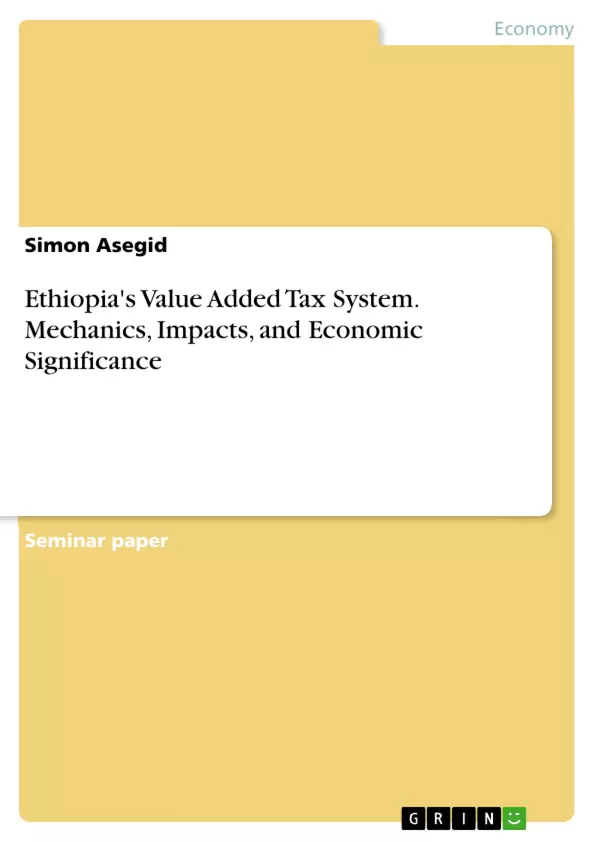This study examines Ethiopia's Value Added Tax (VAT) system, its administration, impacts, and significance within the country's economic and public finance landscape. It analyzes how well the VAT system aligns with principles of good taxation, such as equity, efficiency, and revenue generation, and identifies key challenges. The study employs a qualitative approach, reviewing relevant literature, legal/policy documents, and secondary data to understand the theoretical foundations and administrative framework of VAT in Ethiopia. The data collection involved document analysis of reports on implementation challenges and case studies. The findings indicate that the adoption of VAT in 2003 was a key component of Ethiopia's domestic revenue reforms, aimed at reducing reliance on foreign aid and grants. VAT has played a significant role in mobilizing domestic resources to finance development priorities. However, the study also highlights administrative and integration challenges, such as compliance issues, exemptions, and the need to further strengthen tax administration capacity. The study provides recommendations to strengthen VAT collection and compliance, as well as address the identified challenges. These include improving taxpayer education and engagement, enhancing electronic invoicing and data-driven compliance management, and reviewing the VAT exemption structure to better align with principles of equity and efficiency. The analysis of Ethiopia's VAT system offers insights into the challenges and opportunities faced by developing countries in implementing effective consumption-based tax reforms to support sustainable development and public finance management.
Inhaltsverzeichnis (Table of Contents)
- Introduction
- Objective
- General Objective
- Specific Objective
- Methodology
- Literature Review and Theoretical Framework
- Principles of Taxation
- Objectives of Taxation
- Distributional Effects and Equity
- Tax Burden and Compliance
- Revenue and Expenditure Policies
- Revenue Concept
- Exemption
- Reduction
- Rates: Face Rate, Effective Rate
- Revenue Liability and Revenue Structure
- Revenue Expenditure
- Delinquency
- Incidence
- Progressivity, Proportional, Regressive
- Elasticity/Inelasticity
- Non-neutralities
- Earmarked Revenue
- Revenue Performance
- Trends in VAT Collection
- Compliance with Principles
- Challenges
- Administrative Issues
- Integration Challenges
- Conclusion
- Recommendations
- References
Zielsetzung und Themenschwerpunkte (Objectives and Key Themes)
This paper aims to provide a comprehensive analysis of Ethiopia's Value Added Tax (VAT) system, examining its administration, impacts, and significance within the country's economic and public finance landscape. It will explore how well the VAT system aligns with principles of good taxation, such as equity, efficiency, and revenue generation, and identify the challenges it faces.
- The implementation and administration of VAT in Ethiopia
- The impact of VAT on the Ethiopian economy and public finances
- The alignment of VAT with principles of good taxation
- Challenges faced in implementing and enforcing VAT in Ethiopia
- Recommendations to strengthen VAT collection and compliance
Zusammenfassung der Kapitel (Chapter Summaries)
The introduction provides an overview of VAT, explaining its global prevalence and significance for developing countries. It outlines the rationale for Ethiopia's adoption of VAT in 2003, emphasizing its importance for mobilizing domestic resources, achieving the Sustainable Development Goals, and transitioning to middle-income status. The introduction also highlights VAT's unique features and its role in Ethiopia's economic development.
The literature review section explores the theoretical framework for VAT, focusing on principles of taxation and the objectives of tax policy. It examines equity, efficiency, and simplicity as guiding principles for tax policy design and implementation. The section also delves into the objectives of taxation, including revenue generation, economic regulation, and distributional effects and equity.
The paper further examines concepts related to revenue, including exemption, reduction, tax rates, revenue liability, expenditure, delinquency, incidence, progressivity, elasticity, and earmarked revenue. It explores the performance of VAT in Ethiopia, analyzing trends in collection and compliance with tax principles.
The paper concludes with a discussion on challenges faced in implementing and enforcing VAT in Ethiopia, encompassing administrative and integration issues. The paper emphasizes the need for a strong administration and robust legal framework to ensure effective implementation of VAT.
Schlüsselwörter (Keywords)
The key focus areas of this paper are Value Added Tax (VAT), tax policy, public finance, economic development, equity, efficiency, compliance, revenue generation, Ethiopia, and challenges in implementing VAT in developing countries.
- Citar trabajo
- Simon Asegid (Autor), 2024, Ethiopia's Value Added Tax System. Mechanics, Impacts, and Economic Significance, Múnich, GRIN Verlag, https://www.grin.com/document/1490176



